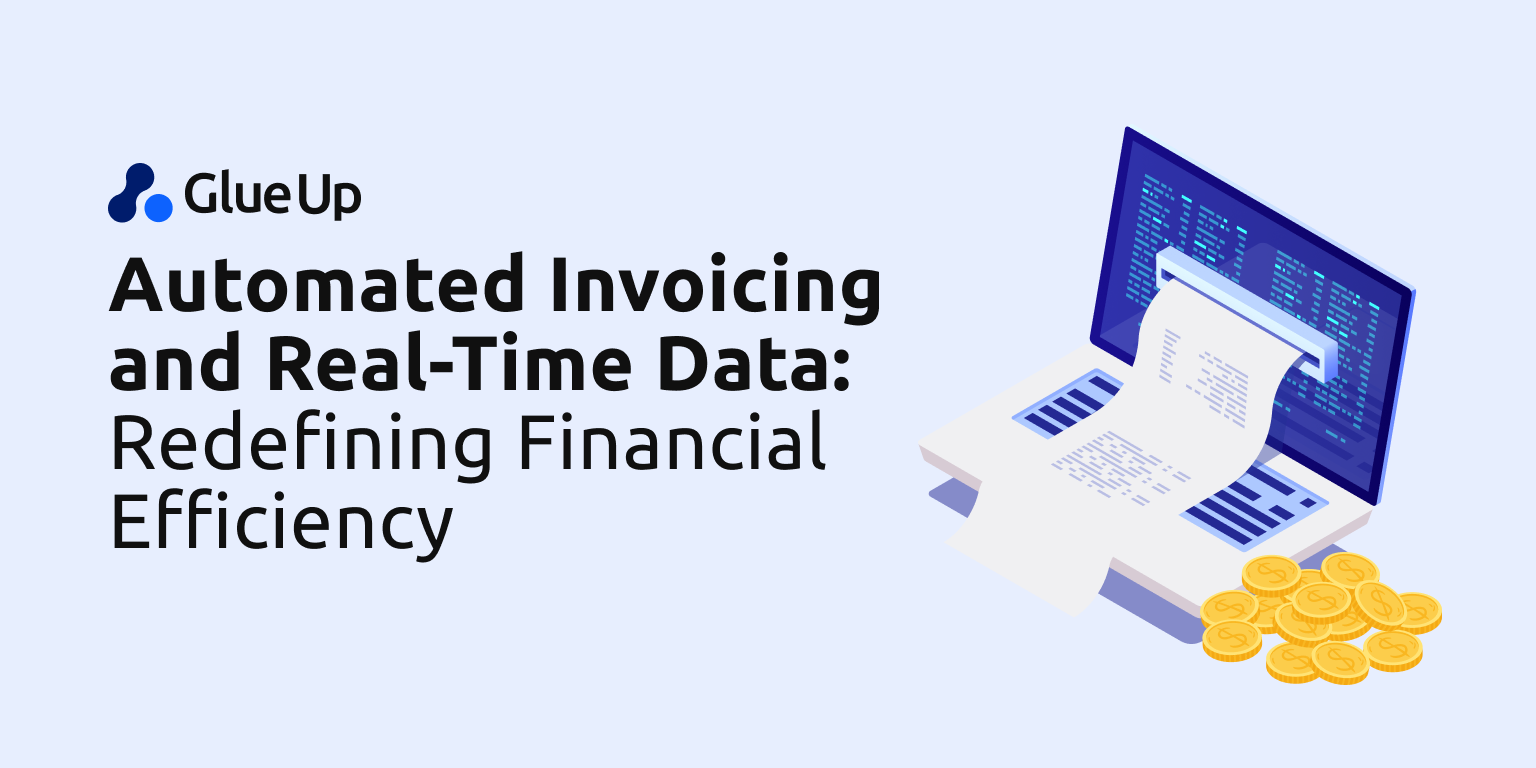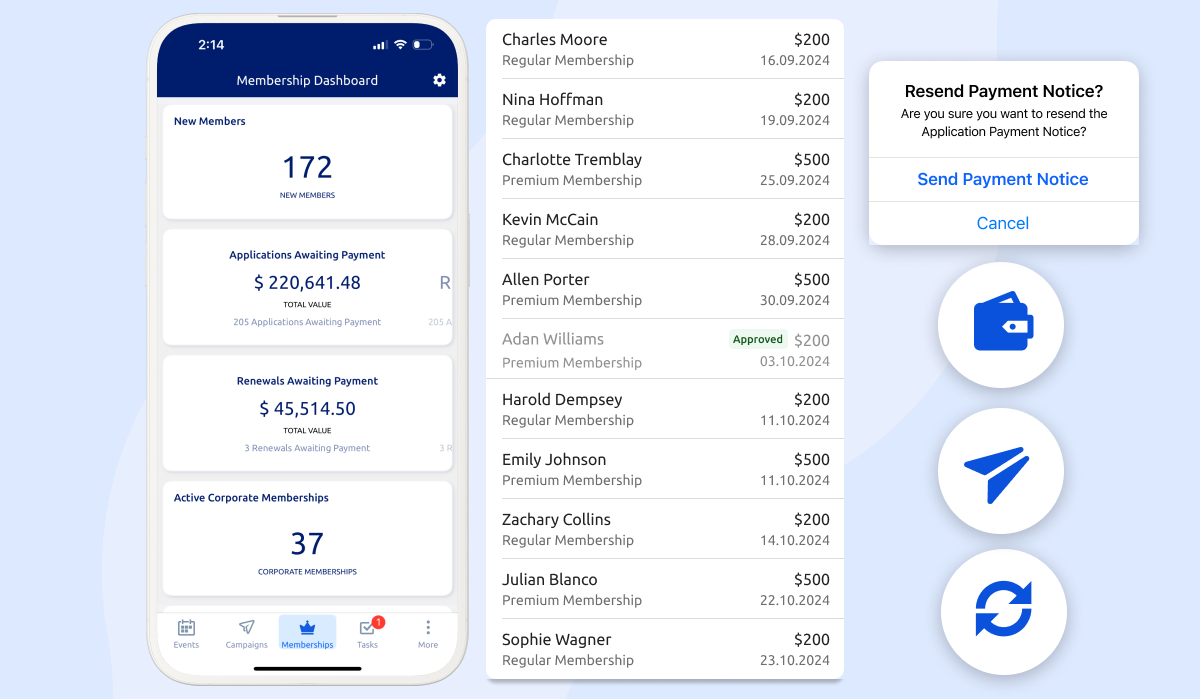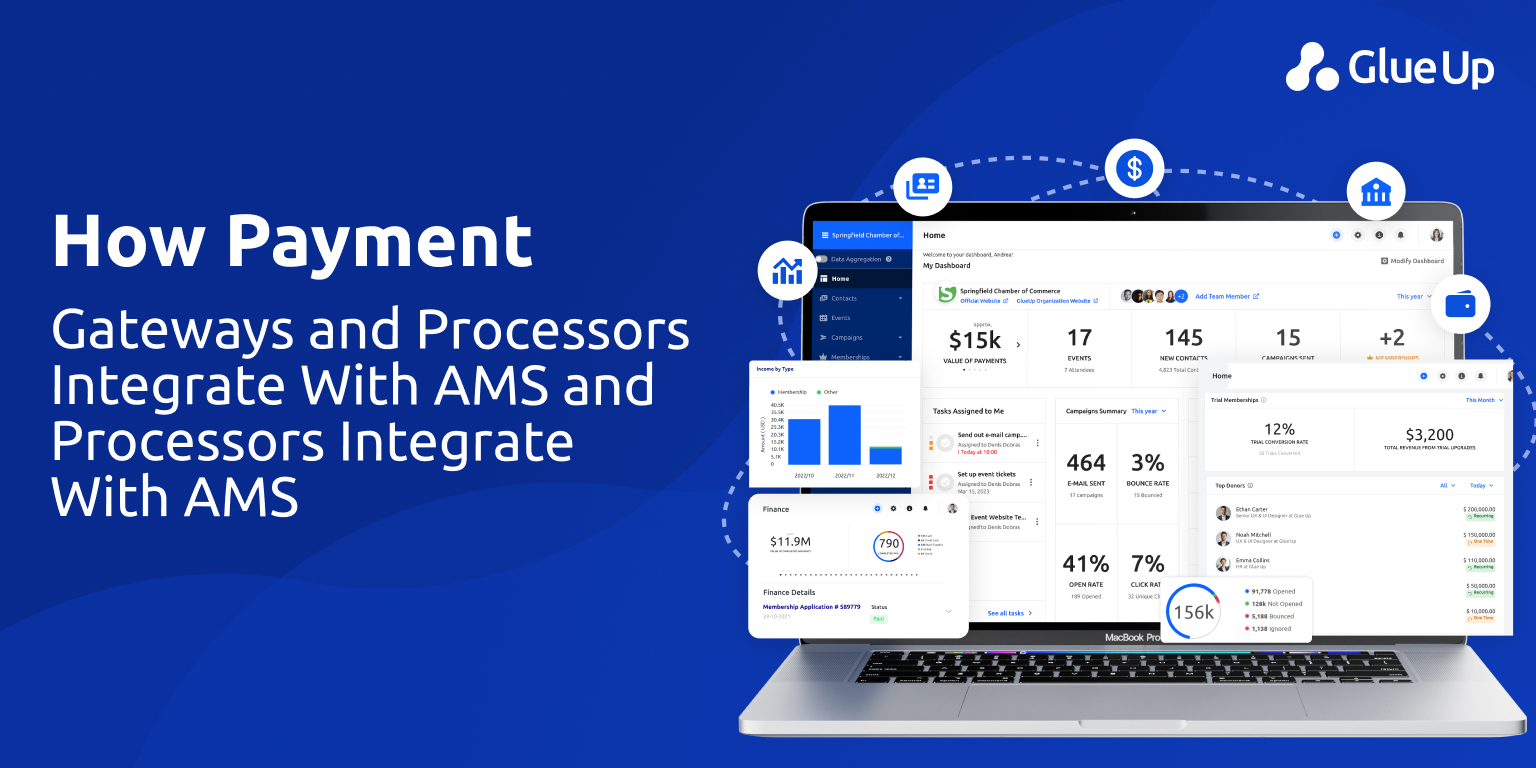
Nearly 2 in 5 CFOs report their accounts receivable teams are weeks or months behind and will never catch up on invoices due to the overwhelming volume of manual processes and outdated systems.
For organizations managing thousands of members, manual invoicing can consume countless hours, leaving no time for other important tasks.
Delays in updating financial records after transactions further complicate efforts to assess cash flow status accurately. Associations facing these challenges often struggle without automation.
Automated invoicing and real-time data updates streamline processes, provide instant insights, and save time while improving financial accuracy. The blog explores how these tools redefine financial management for organizations, address pain points, and enable smarter, faster decision-making.
Stay tuned to learn their importance and impact on member-based organizations.
Key Takeaways
Organizations relying on manual invoicing face high costs, time-consuming tasks, frequent errors, and cash flow bottlenecks, which hinder efficiency and growth.
Real-time financial updates enable organizations to monitor their financial standing, make accurate projections, resolve disputes promptly, and maintain compliance. Automated systems mitigate the risks of human error in financial reporting, ensuring compliance with regulations. They also improve relationships with members and vendors through timely payments and accurate invoicing.
Real-world examples, such as the County Kildare Chamber and BC Chamber of Commerce, illustrate how automation and real-time insights improve financial accuracy, streamline processes, and support organizational growth.
Glue Up’s all-in-one platform automates invoicing, provides real-time analytics, and centralizes financial processes, enabling organizations to save time, reduce costs, and focus on member engagement and growth.
The Problems With Manual Financial Processes

Avoiding the automation of financial processes can lead to several critical challenges. Let’s explore the major issues:
1. Higher Costs
Financial processes that rely heavily on manual effort tend to be significantly more expensive than automated alternatives. Statistics reveal that automated invoicing processes cost between 40% and 90% of manual and paper-based methods.
Redirecting these savings toward strategic areas of your organization can improve overall efficiency.
2. Time-Consuming Tasks
Processing financial transactions without automation consumes valuable work hours. Tasks like reconciling accounts payable and accounts receivable or handling repetitive invoices can take days to complete.
Automation, on the other hand, performs these tasks in a fraction of the time, allowing your team to focus on growth-oriented activities.
According to research, finance automation solutions increase operational efficiency by 70%, allowing CFOs to focus on high-leverage tasks and achieve faster turnaround times.
3. Frequent Errors
High levels of human involvement in financial processes increase the chances of errors. For example, composite organizations spend $24,000 annually on manual cash application errors, which result in poor customer experiences, delayed payments, and unpaid invoices. Moreover, 61% of late payments stem from incorrect invoices, an issue easily avoided with automation.
4. Cash Flow Bottlenecks
Delays in updating financial records create cash flow bottlenecks, where organizations struggle to track income and expenses accurately. If there are no timely insights, operational decisions can suffer, and opportunities for optimization are often missed.
5. Weakened Relationships With Members and Vendors
Late payments, incorrect invoices, and slow resolution of disputes can weaken your relationships with both members and vendors. Members may lose trust in your organization, while vendors could grow reluctant to work with you due to delays or inaccuracies.
Automation guarantees faster, more accurate transactions, improving trust and building stronger connections.
6. Compliance Risks
Traditional record-keeping methods increase the likelihood of errors in financial reporting, leading to potential non-compliance with regulations. This exposes organizations to penalties and reputational risks that automation can easily mitigate.
7. Poor Scalability
Growth in transaction volumes and member bases puts a strain on outdated financial systems. No automation leads to inefficiencies and wasted resources. Automated processes, however, scale effortlessly to meet growing demands.
8. Reduced Employee Satisfaction
Repetitive and mundane financial tasks can demotivate employees, reducing morale and productivity. Automating these tasks allows staff to focus on more meaningful and strategic work, improving job satisfaction and engagement.
To sum up, continuing to avoid automation keeps your organization stuck in inefficiency and limits its growth potential.
Power of Real-Time Financial Reporting

Since we’ve discussed the challenges caused by a lack of automation in invoicing and finance, let’s explore how real-time financial reporting benefits member organizations.
1. Always Stay Updated
Real-time reporting keeps you constantly aware of your financial position. Knowing your organization’s financial standing, what’s missing, and where action is needed simplifies follow-ups and necessary steps.
Without this clarity, addressing one issue often leads to others cropping up, creating a cycle of inefficiency.
2. Quick And Informed Decision-Making
Immediate updates allow your team to respond promptly to issues such as a non-performing payment method or disruptions in a payment channel. The agility you get with real-time updates minimizes risks and maintains smooth operations.
3. Transparency And Clarity
Real-time reporting provides a clear view of your organization’s financial health. You can track incoming cash, outgoing expenses, losses, profits, revenue, and overall spending. Such a level of clarity keeps you prepared for any challenges.
4. Accurate Projections And Budgeting
Access to real-time data makes creating financial projections more realistic. Unlike assumptions based on outdated or incomplete information, projections with real-time insights are reliable and actionable. This also supports more effective budgeting for association spending.
5. Better Planning And Member Focus
Real-time reporting allows you to identify key areas of improvement, plan better for member needs, and allocate resources where they matter most. Eventually, it helps deliver greater value and support to your members.
6. Quick Dispute Resolution
Disputes can be resolved on the spot with immediate access to accurate data. Real-time updates also help respond promptly to member queries related to financial matters, building trust and satisfaction.
7. Improved Cash Flow Management
Access to real-time insights allows constant monitoring of cash flow, helping you maintain liquidity and avoid financial disruptions.
8. Enhanced Compliance
Up-to-date financial records simplify meeting regulatory requirements, reducing risks of penalties and ensuring compliance.
9. Stronger Stakeholder Communication
Real-time financial data makes it easier to provide transparent updates to stakeholders, such as board members or sponsors, promoting trust and credibility.
How Organizations Can Streamline Finances With Automation and Real-Time Insights

Implementing a finance management solution that offers accurate, fast, effective, and scalable tools is the best way to achieve financial efficiency. Relying on manual processes or fragmented systems often leads to inefficiency, missed opportunities, and delayed payments.
To make progress, scale operations, and position your organization as a trusted name among members and potential members, adopting an efficient finance management solution is essential. One all-in-one solution designed specifically for organizations, associations, chapters, and chambers is Glue Up.
Here’s what Glue Up brings to the table to streamline your financial processes:
Automate Manual Tasks
Simplify invoicing and payment processes from start to finish without compromising on security. Automation reduces errors, speeds up payment cycles, and frees up staff for higher-value activities.
Automatic Invoicing: Automatically generate and send invoices to members, reducing administrative workload and ensuring timely payments.
Custom Reminders & Notifications: Set automated reminders to minimize late payments and improve member retention with consistent follow-ups.
Customizable Tax Setup: Easily configure tax settings for invoices, making compliance with local regulations seamless and accurate.
Coupons & Discounts: Offer targeted promotions or discounts to members while maintaining clear financial records and avoiding manual tracking errors.
Centralize and Track All Payments
Real-time tracking and centralized payment data eliminate guesswork and delays, giving you clear visibility into your financial health. Quick access to insights enables better cash flow management and informed decision-making.
P&L Reports: Instantly generate profit and loss statements to assess financial performance and make informed strategic decisions.
Real-Time Analytics: View your financial data live to track payment trends, manage cash flow, and identify areas for improvement.
Customizable Dashboards: Create tailored dashboards to monitor key financial metrics and confirm that you are meeting your financial goals.
Easy Data Export: Seamlessly export financial data for analysis or reporting, saving time and ensuring accuracy in documentation.
Boost Financial Efficiency With Real-Time Insights
Glue Up’s real-time analytics provide an up-to-date picture of your organization’s finances, helping you address potential issues before they escalate.
Real-time data allows for accurate forecasting and better financial planning, whether monitoring cash flow, identifying overdue invoices, or tracking spending trends.
Glue Up’s features streamline financial management and empower organizations to focus on what truly matters: serving members and driving growth. Book a demo today to discover how Glue Up can transform your financial processes and help you achieve greater efficiency.
Turning Challenges Into Solutions: Real Examples of Finance Automation
Here, we’ll share real examples of how organizations have used automation to tackle inefficiencies in financial processes and inspire actionable change.
From streamlining repetitive tasks to leveraging real-time insights, these stories showcase the transformative benefits of automating financial operations.
Case Study 1: How County Kildare Chamber Streamlined Finances With Automation
County Kildare Chamber’s partnership with Glue Up marked a significant shift in its financial processes, particularly in automating operations and utilizing real-time data. Previously relying on Excel templates and outdated systems, the Chamber faced challenges in tracking financial data accurately and efficiently.
Glue Up transformed these processes by automating the generation and dispatch of invoices, enabling timely and accurate payments through strategically scheduled reminders. Automation reduced manual workload and saved the Chamber significant time and costs.
The integration of real-time reporting provided an up-to-date and clear picture of its financial performance, fostering agile decision-making and improved financial planning. These advancements allowed the Chamber to focus on its broader mission of supporting business growth while achieving scalability and operational efficiency.
Case Study 2: Optimizing Financial Efficiency at the BC Chamber of Commerce
Glue Up’s partnership with the British Columbia Chamber of Commerce transformed its financial processes through automation and real-time data management.
The adoption of Glue Up’s automated billing workflow streamlined extensive workloads, enabling a single finance team member to manage tasks efficiently. Automation minimized manual paperwork, improved operational efficiency, and reduced reliance on external contractors.
Transitioning from Mailchimp to Glue Up enhanced data and subscriber list management, improved financial integrity, and empowered the team to work more independently.
Glue Up’s platform also facilitated real-time conversations and resource sharing across a network of 100 chambers of commerce, centralizing communication and providing immediate solutions to member challenges.
These advancements optimized financial operations, maintained data accuracy, and delivered greater value to members.
Closing the Loop: Why Financial Automation Matters
Financial automation simplifies processes, improves member satisfaction, reduces compliance risks, and prepares organizations for future challenges.
Timely and accurate billing builds trust and transparency, while automated tools mitigate compliance risks and streamline reporting with precise audit trails.
Integrating automation with CRMs and membership databases creates a unified approach, aligning financial processes with engagement strategies. It’s not just for chambers; automation benefits any member-based organization by supporting smarter budgeting, efficient renewals, and real-time reporting.
Looking ahead, emerging technologies like AI-driven analytics and blockchain offer even greater opportunities, making financial automation a reliable and forward-thinking investment.
Ready to experience these benefits? Request a demo for Glue Up and take the first step toward smarter financial management.



